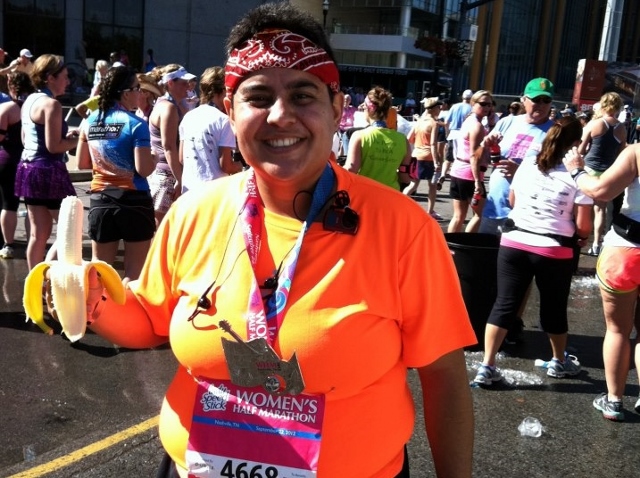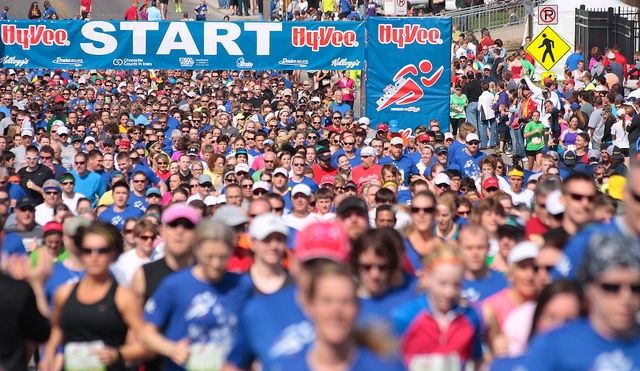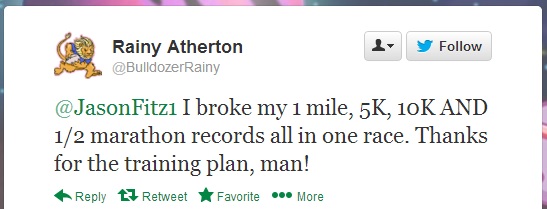Confession: I have a love-hate relationship with the half.
It’s a fantastic distance and half marathon training isn’t nearly as grueling as marathon preparation, so it’s much easier to do.
But I’ve never actually run a good half marathon! My personal best is from my very first race – and I don’t think I’ve ever run a “good” one.
One of these days I’ll redeem myself. Until then, I want to help coach you through several key elements of sound training for the half – and indeed, any race.
But today we’re going to look at half marathon training through the lens of Rainy’s success. She’s a beginner runner who had run several HM’s in the past but was ready for more structure.
She wanted to see more results and thought a training plan would help give her the consistency she needed for another personal best. She was right.
Half Marathon Training Needs Progression
Rainy’s training before her Strength Running race plan was typical of many new runners: no workouts, no specific plan, and little consistency. Just a few easy runs per week in the 3-6 mile range.
She was having fun and losing weight in the process though – even posting an impressive PR streak in her first three half marathons of 2:57, 2:50, and 2:48.
Like many runners, Rainy became interested in performance. She wanted to run faster and knew that if she could see some real improvements, she’d be less likely to quit (sometimes for weeks at a time).
After starting her training plan, Rainy saw that training progression is essential for continued improvement.
The biggest change was having a plan that built on itself. I knew that if I didn’t complete most of the runs that I wouldn’t be able to complete the end of the plan – unless I had prepared for it gradually.
So I got a structured, planned, challenging, stretch-goal type of progression with the plan. I didn’t have that before; all I had was some vague 10% rule that I was not exactly sure how to implement.
As Rainy went through her half marathon training, she found that progression actually worked! She became a lot more consistent because she realized that if she fell off the wagon for a week, it affected the entire progression of workouts – and ultimately how well you race.
Training is cumulative – what you do today affects what you’re able to do tomorrow and next week. Rainy’s continued success in the half is a testament to being able to progressively run more and do faster workouts.
The clear progression was one of her favorite aspects of the program (and a huge reason why Rainy set a new personal best).
Rainy had a Half Marathon Time Goal
You don’t need a time goal if you’re running a race. In fact, if you’re just running for general health, weight loss, or the camaraderie of a running group then that’s just awesome.
But a performance goal – like a certain time to beat – can make things a little more fun. Rainy said:
I had a clearly defined PR goal that I thought was just a bit beyond me, but perhaps possible (the big exciting goal you talked about in the Boot Camp).
When you start having time goals, you’re no longer running. You’re training. But don’t mistake that for being a super-serious runner who never has any fun – tracking improvements can actually be a blast!
Rainy found that training makes running less boring. Now she can keep track of speed, distance, and time which makes it less likely for her to skip a run.
Those performance metrics make her want to be able to do it and provides a “just out of reach goal” to strive for that helps her get out there and give it her best.
Ingredient #3: A Deadline!

We’ve all heard that goals aren’t good goals until they’re measurable – and one of the best ways to do that is to set a deadline for yourself.
That’s exactly what Rainy did. By registering for a race, she knew she had a limited time to train and prepare herself for 13.1 miles.
There was no some day.
There was no I’ll do it later.
There was no I should really get on that…
There was only I have 3 months to make this happen! Giddy up!
Rainy registered for the Rock ‘n Roll Half Marathon in Chicago, giving herself exactly 12 weeks to prepare.
When you combine a logical progression with a deadline, you have a clear outline of what you need to accomplish between now and the date of your race. If you’re bouncing from one workout to another with no race goal in mind, you might be able to reach a whole new level of performance just by committing to a race 3-5 months from now.
Rainy PAID for her Half Marathon Training
Rainy had done what she could without a training plan – losing 40 pounds and setting multiple PR’s in the process – but she knew structure would help her run even better.
By purchasing a training plan, Rainy put her money where her mouth is and committed her hard earned dollars to her goals, elevating their importance. Now she was at risk of losing money if she fell off the wagon and lost consistency. And nobody likes wasting money.
In addition to increasing her commitment, she was able to assign more value to her training plan than if she downloaded a free plan somewhere else. You value what you pay for more than what you get for free.
But she was also careful not to just “throw money” at her race goals, thinking that a training plan would make them magically come true.
Rainy knew that success required hard work and consistency. So she bargained with herself.
I’ve tried throwing money at the problem before. Once, I signed up for a half marathon a year out thinking the steep entry fee would make me train. Not so! I just didn’t show up on race day.
I finally decided to buy the plan as a reward when I had sufficiently proven to myself that running was a habit, which I could keep up.
Her reward paid off.
How much? Well, the “big, exciting goal” she set for herself was 2:25 in the half marathon.
And she beat that goal by almost 2 minutes with a chip time of 2:23:03! And she set a few more personal bests along the way…
Half marathon training – and indeed any race training – should be built on the principles of progression, motivation, and clear goals. If you get those elements right, the running almost takes care of itself.
We’ll end with sage advice from Rainy:
If you don’t have motivation and determination, you can’t buy it. But if you are motivated, I think having a plan, a goal, a deadline and a clear roadmap can be super helpful. As a tool, not a magic pill.
If you’d like to learn more about how a Strength Running program can help your running, get all the details on the training plan page here.

